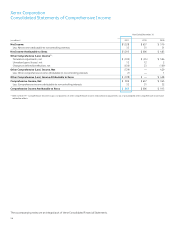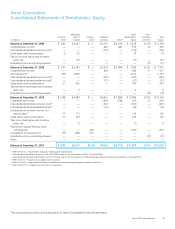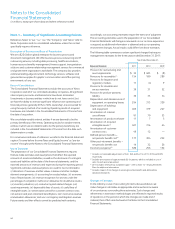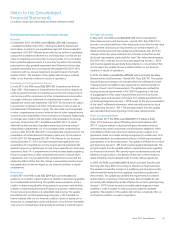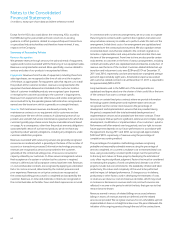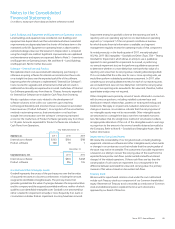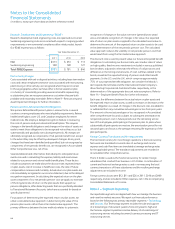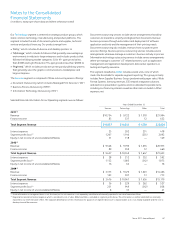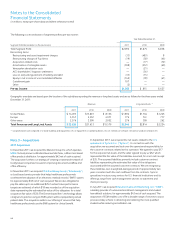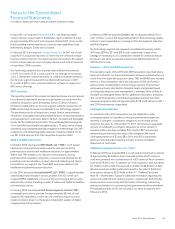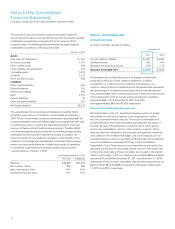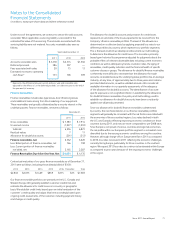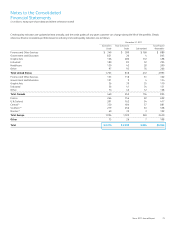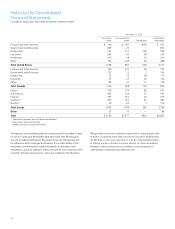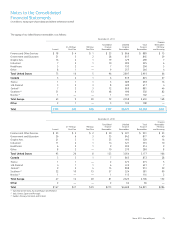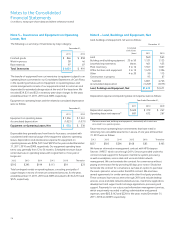Xerox 2011 Annual Report Download - page 68
Download and view the complete annual report
Please find page 68 of the 2011 Xerox annual report below. You can navigate through the pages in the report by either clicking on the pages listed below, or by using the keyword search tool below to find specific information within the annual report.
66
recognition of changes in fair value over time (generally two years)
versus immediate recognition of changes in fair value. Our expected
rate of return on plan assets is applied to the calculated asset value to
determine the amount of the expected return on plan assets to be used
in the determination of the net periodic pension cost. The calculated
value approach reduces the volatility in net periodic pension cost that
would result from using the fair market value approach.
The discount rate is used to present value our future anticipated benefit
obligations. In estimating our discount rate, we consider rates of return
on high-quality, fixed-income investments included in various published
bond indexes, adjusted to eliminate the effects of call provisions and
differences in the timing and amounts of cash outflows related to the
bonds, as well as the expected timing of pension and other benefit
payments. In the U.S. and the U.K., which comprise approximately
75% of our projected benefit obligation, we consider the Moody’s
Aa Corporate Bond Index and the International Index Company’s
iBoxx Sterling Corporate AA Cash Bond Index, respectively, in the
determination of the appropriate discount rate assumptions. Refer to
Note 14 – Employee Benefit Plans for further information.
Each year, the difference between the actual return on plan assets and
the expected return on plan assets, as well as increases or decreases in the
benefit obligation as a result of changes in the discount rate, are added to
or subtracted from any cumulative actuarial gain or loss from prior years.
This amount is the net actuarial gain or loss recognized in Accumulated
other comprehensive loss and is subject to subsequent amortization to
net periodic pension cost in future periods over the remaining service
lives of the employees participating in the pension plan. In plans where
substantially all participants are inactive, the amortization period for net
actuarial gains and losses is the average remaining life expectancy of the
plan participants.
ForeignCurrencyTranslationandRe-measurement
The functional currency for most foreign operations is the local currency.
Net assets are translated at current rates of exchange and income,
expense and cash flow items are translated at average exchange rates
for the applicable period. The translation adjustments are recorded in
Accumulated other comprehensive loss.
The U.S. Dollar is used as the functional currency for certain foreign
subsidiaries that conduct their business in U.S. Dollars. A combination of
current and historical exchange rates is used in re-measuring the local
currency transactions of these subsidiaries and the resulting exchange
adjustments are included in income.
Foreign currency losses were $12, $11 and $26 in 2011, 2010 and 2009,
respectively, and are included in Other expenses, net in the accompanying
Consolidated Statements of Income.
Note 2 – Segment Reporting
Our reportable segments are aligned with how we manage the business
and view the markets we serve. We report our financial performance
based on the following two primary reportable segments – Technology
and Services. Our Technology segment includes the sale and support
of a broad range of document systems from entry level to high-end.
Our Services segment operations involve delivery of a broad range of
outsourcing services including document, business processing and IT
outsourcing services.
Research,DevelopmentandEngineering(“RD&E”)
Research, development and engineering costs are expensed as incurred.
Sustaining engineering costs are incurred with respect to ongoing product
improvements or environmental compliance after initial product launch.
Our RD&E expense was as follows:
Year Ended December 31,
2011 2010 2009
R&D $ 613 $ 653 $ 713
Sustaining engineering 108 128 127
Total RD&E Expense $ 721 $ 781 $ 840
RestructuringCharges
Costs associated with exit or disposal activities, including lease termination
costs and certain employee severance costs associated with restructuring,
plant closing or other activity, are recognized when they are incurred.
In those geographies where we have either a formal severance plan
or a history of consistently providing severance benefits representing
a substantive plan, we recognize severance costs when they are both
probable and reasonably estimable. Refer to Note 9 – Restructuring and
Asset Impairment Charges for further information.
PensionandPost-RetirementBenetObligations
We sponsor defined benefit pension plans in various forms in several
countries covering employees who meet eligibility requirements. Retiree
health benefit plans cover U.S. and Canadian employees for retiree
medical costs. We employ a delayed recognition feature in measuring
the costs of pension and post-retirement benefit plans. This requires
changes in the benefit obligations and changes in the value of assets set
aside to meet those obligations to be recognized not as they occur, but
systematically and gradually over subsequent periods. All changes are
ultimately recognized as components of net periodic benefit cost, except
to the extent they may be offset by subsequent changes. At any point,
changes that have been identified and quantified, but not recognized as
components of net periodic benefit cost, are recognized in Accumulated
Other Comprehensive Loss, net of tax.
Several statistical and other factors that attempt to anticipate future
events are used in calculating the expense, liability and asset values
related to our pension and retiree health benefit plans. These factors
include assumptions we make about the discount rate, expected return
on plan assets, rate of increase in healthcare costs, the rate of future
compensation increases and mortality. Actual returns on plan assets are
not immediately recognized in our income statement, due to the delayed
recognition requirement. In calculating the expected return on the plan
asset component of our net periodic pension cost, we apply our estimate
of the long-term rate of return on the plan assets that support our
pension obligations, after deducting assets that are specifically allocated
to Transitional Retirement Accounts (which are accounted for based on
specific plan terms).
For purposes of determining the expected return on plan assets, we
utilize a calculated value approach in determining the value of the
pension plan assets, rather than a fair market value approach. The
primary difference between the two methods relates to systematic
Notes to the Consolidated
Financial Statements
(in millions, except per-share data and where otherwise noted)


